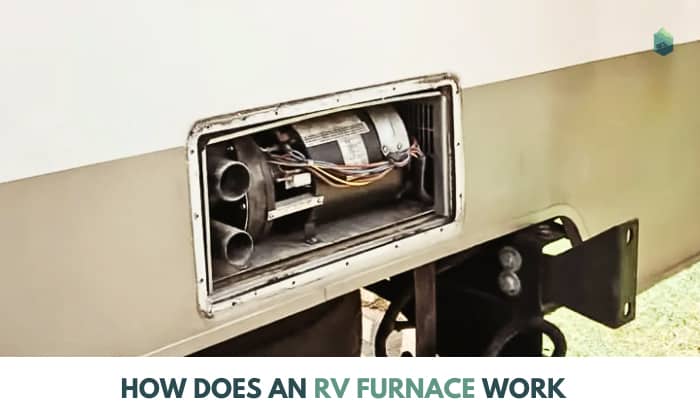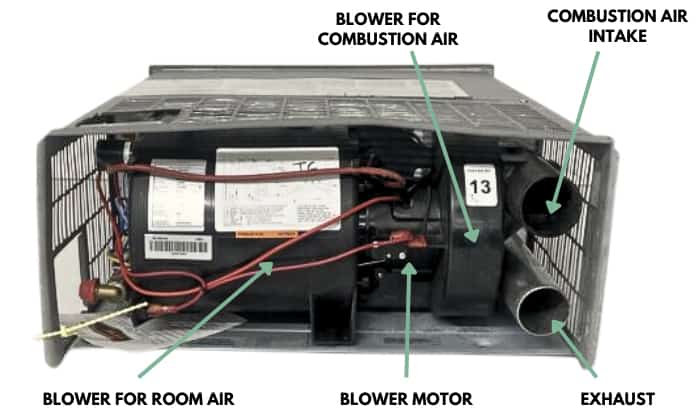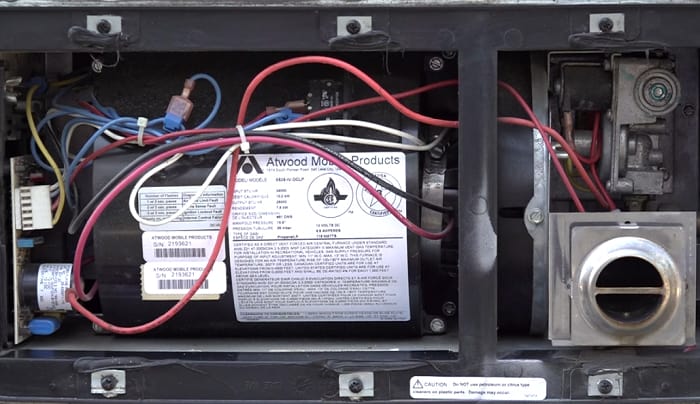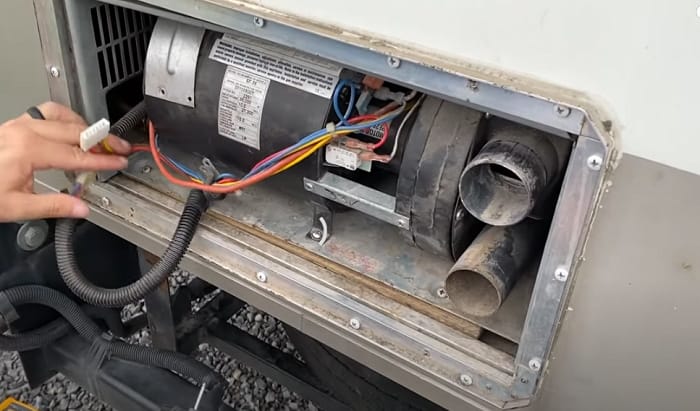Winter season has arrived, and for camping activities, ensuring sufficient warmth inside your RV is essential. Therefore, a furnace becomes indispensable for all campers.
A furnace is a structure that blows up heated air into different motor pool areas. It keeps the travel trailer conducive for living and comfortable to stay in. Besides keeping the air quality clean and improved, having a furnace is a safe and affordable investment.
However, the question is how does an RV furnace work? Read on and discover it in this article.
Page Contents
How an RV Furnace Works
Almost any camper has a built-in furnace. The furnace is the main source of heat in a camper that prevents the pipes and tubes from freezing when the temperature is cold.
Generally, an RV furnace can be powered either by electricity or propane. However, if you are traveling without a power supply, using a trailer heater propane is the best option.
A camper furnace propane can function properly with thermostat, exhaust vent, blower motor, sail switch, module board, and air intake vent.
When we set the thermostat higher than the RV’s interior temperature. When the blower motor starts, the propane burns to release hot air inside the van.
Steps Involved in Operating an RV Propane Heater
If you are using RV furnace for first time, you might be asking yourself how do RV furnaces work. It seems complicated, but the process is simple.
The following steps will tell you how to operate a gas heater for an RV:
Step 1. Turn on the furnace in travel trailer by slowly opening the propane valve to let the gas pass through the furnace.
Step 2. Set the heat setting on the thermostat. When set, the thermostat’s ON/OFF switch controls whether air current will flow through it in response to a call and the relay.
After this command, the relay passes the heating coil as it continues via the relay circuit. The propane heater for an RV then starts.
Step 3. Close the sail switch when the furnace reaches the desired temperature to start the furnace. Connections in the sail switch, however, open if the temperature rises over the recommended level, shutting off the ignition system.
It takes around 15 seconds for pre-purge cycles to finish, allowing the combustion chamber enough time to purge.
Step 4. The electrode will be ignited for 7 seconds by electricity flowing to the gas valve in the next phase. When the module board determines that the main burner effectively starts, the ignition will stop, but the gas valve and blower motor will keep working.
Step 5. There will be a 15-second purge cycle and a second Trial-For-Ignition process if the module board does not detect a flame after 7 seconds.
If the main burner doesn’t light after three attempts at ignition, the gas valve will turn off. After three more minutes, the blower will shut off in lockout mode.
Step 6. The limit switch is closed while the heating cycle is in progress. The gas valve will eventually close while the blower motor is still running after it opens and stays open for some time.
Step 7. When the gas valve attains the required heat, it is de-energized, which causes the flame to die out. Ninety seconds later, the post-purge period starts, and the blower turns off.
Amount of Propane An Heater Use
Knowing the exact amount of propane used by an RV is hard to quantify since there are different factors that you must consider. On average, when propane continuously runs, it might use ⅓ gallon of propane every hour.
First, you must know how much heat is needed to raise the temperature of the RV by knowing the furnace’s British Thermal Units (BTU). To ensure the BTU rating of the RV, you may see the manual.
Once you know this rating, you can start our calculations.
RV Propane Heater Troubleshooting
To have a high efficiency RV furnace, you should know how to troubleshoot a RV propane furnace whether it is a small propane heater or not.
- No Heat
When you turn on the furnace and the heat temperature remains below the temperature set on the thermostat, or if there is no heat at all, there must be some electrical problem.
You must check if the propane tank is on. If there is still no heat, a fuse replacement must be the solution to the problem.
If the propane tank is not the problem, check on the thermostat and the motor to fix it.
- Failing Sail Switch
After hearing the motor starting up and no other noises and nothing happening after turning it on, there is something wrong with the sail switch. You can fix it with little work since the switch could just be stuck.
However, after fixing the switch and there is still no result, you must replace it for the safety and efficiency of the heater.
- Has a Foul Smell
If you are using the furnace regularly, the smell is not normal. But if the furnace has been stuck for several months and not used, having a foul smell seems normal because of the dust and debris that built into it.
Hence, you should regularly monitor the smell to prevent risks.
- Unit Won’t Light
Check if the RV furnace has enough propane to run. If there is enough propane yet the unit won’t light, the thermocouple might be the cause. It must be in the proper position and free from webs and bugs.
Cleaning these will fix the problem, but if not, the solution should be to change the thermocouple to the same brand.
- Propane and Electricity Run out
When the RV furnace run off propane or electric, you can opt for a space heater like a vented propane heater, RV will love this as it is a space saver.
Aside from this, there are electric heaters and electric blankets which you can use in your winter travel.
Frequently Asked Questions
Are RV propane furnaces safe?
Yes, using RV propane furnaces is safe when you do it properly. It needs full attention and proper maintenance to ensure that it is safe. Also, you must keep a propane detector that is working so that you can monitor it properly.
What is the best propane heater for an RV?
Here’re some recommendations on the best RV propane heater you can choose from:
- Heater Portable Buddy
- Lasko Ceramic
- Heater Little Buddy
- Camco Catalytic
- Heater Big Buddy
- Dometic RV furnaces
Do RV furnaces run on electricity?
RV furnaces run on both electricity and propane. Generally, RV furnaces are powered with 12-volt electricity to heat the entire motor pool during a cold season.
If you are boondocking and without propane, electricity is the best alternative.
How long will an RV furnace run on propane?
Typically you don’t use the RV furnace the whole day. Hence, it depends on factors like the size of a propane tank and the temperature in the area.
For instance, an RV furnace will run on 3 hours of continuous use when using a 20-pound propane tank. It leads to 6 to 7 days of use.
Because of rough computations, it is best to have a spare propane tank with you.
How long does it take for an RV furnace to heat up?
It will take only 15 to 30 seconds to heat an RV furnace. If it does not light up on the first try, you can try it again in another 15 to 30 seconds.
There are instances where it takes 5 minutes to light a propane furnace. However, it should not last for 15 minutes or more. When this happens, it means that there is something wrong with the RV furnace that could need your attention.
Conclusion
Winter travel is one of the most exciting adventures you can have. The challenge, however, is how you can survive in the cold. Worry no more! You can use RV furnaces in your travels which is an excellent investment for a traveler like you.
All you need to think of is what size RV furnace to choose to heat your entire space. When you already have one, we hope this article helps you answer the “How does an RV furnace work?”.
Read next: Common RV furnace location

My career journey has been marked by a variety of roles. I served as a Personal Trainer for Children, Fitness Instructor, and Home-Based Consultant in Detroit Wayne Integrated Health Network.
More than ten years of traveling in my caravan have lent me a deep appreciation of freedom. Without the shackles of being tied down to one place, I get to explore many parts of the world and relish the exhilaration that comes with discovering new things. Throughout my journey, I have been a member of FMCA (Family Motor Coach Association) since 2020. Thus, living on the road has never become boring for me.
As someone with a burning passion for traveling, I want to inspire others to adopt a nomad lifestyle to appreciate the beauty of the world. This, of course, requires a functioning vehicle that can always make you feel at home, even when you’re far away from modern life.
Therefore, I seek to put my experience to good use—helping you with your adventure on the road. As a result, I launched and managed the Outdoorbits website, where I likely share my enthusiasm for outdoor activities and health-related insights.



